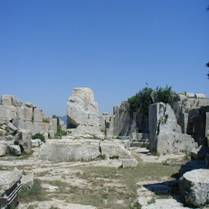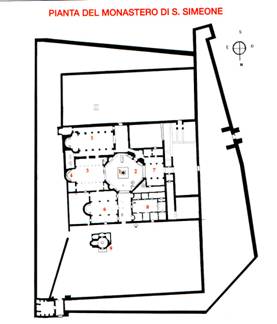| MONASTERY OF ST. SIMEON STYLITE "THE YOUNGER" (521-592)
 Stylites is the name given to Christian ascetics of the IV-IV centuries who chose to "live" ? on top of a pillar (stilos). This practice was already common in the pagan era: at certain times of the year, men would climb to the top of a column and stay there for a while, in order to be closer to the divinity. In the Christian world, the initiator of this way was St. Simeon the Elder (390-459). In northern Syria, not far from Aleppo, the ruins of the monastery that bears his name can still be admired today. Stylites is the name given to Christian ascetics of the IV-IV centuries who chose to "live" ? on top of a pillar (stilos). This practice was already common in the pagan era: at certain times of the year, men would climb to the top of a column and stay there for a while, in order to be closer to the divinity. In the Christian world, the initiator of this way was St. Simeon the Elder (390-459). In northern Syria, not far from Aleppo, the ruins of the monastery that bears his name can still be admired today.
St. Simeon the Younger (517-592) was one of his worthy followers. His biography tells us that he was born in Antioch probably around the year 521, the son of John and Martha. He was baptised at the age of two at the shrine of John the Baptist and given the name Simeon. He lost his father in the earthquake of 526, and during his childhood he received enlightenment as to the way he was to follow in order to reach true "wisdom". Simeon then withdrew into the mountains, near the mouth of the river Orontes, a desolate area overrun by wild beasts, taking refuge in a monastery where the monks lived under the guidance of John the Archimandrite.
 The boy was only 6 or 7 years old, but already he astonished the community with his austere penances and precocious healing powers. In those same years he climbed up to a "platform" alongside John, thus beginning life as a stylite, which, from the Feast of Pentecost 551, he continued on a new pillar (erected in the centre of the monastery built under his direction, at an altitude of about 500 m) which can still be seen among the ruins today. The mountain itself was a site of pilgrimage and came to be known as "the mountain of miracles" because of the countless wonders that took place there through Simeon's intercession. The monastery, situated some 10km down the road to Samandag and then to the left for a further 8 km to the summit, is in the form of a cross and contains three churches, each with a triple nave and its different characteristics. The boy was only 6 or 7 years old, but already he astonished the community with his austere penances and precocious healing powers. In those same years he climbed up to a "platform" alongside John, thus beginning life as a stylite, which, from the Feast of Pentecost 551, he continued on a new pillar (erected in the centre of the monastery built under his direction, at an altitude of about 500 m) which can still be seen among the ruins today. The mountain itself was a site of pilgrimage and came to be known as "the mountain of miracles" because of the countless wonders that took place there through Simeon's intercession. The monastery, situated some 10km down the road to Samandag and then to the left for a further 8 km to the summit, is in the form of a cross and contains three churches, each with a triple nave and its different characteristics.
In the first church, built in the classical style, the remains of mosaics can still be seen on the floor. By un invocation at the Theokotos in one tomb just at the entry probably was dedicate at the Our Lady Mary. The central church, dedicated to the Holy Trinity, is the most beautiful, with capitals, architraves and columns, richly carved in a novel style. The third on the other hand is very sober. Called St. Martha's, it was a martyrium ( in the passed, place where a saint was buried) and protected the tomb of St. Simeon and his mother.
The monastery and the pillar were carved out of the mountain with a circular area in the centre, so that pilgrims could listen to the admonitions of the Saint speaking from the top of the pillar. Alongside the first church there is also a small baptistery, with the monks' rooms and other offices opposite. The monastery complex, noteworthy for its walls, cisterns and underground passageways, fell into disuse in 1268 with the departure of the crusaders. It is the sole example in Turkey of monasteries of this kind, and is well worth a visit, not least because of its good state of preservation. Today it is accessible by car or in small buses which take you right to the main entrance. The "mountain of marvels" has been shrouded in obscurity for centuries. Today only the stones remain to witness to the extraordinary adventure of the 'disciples' of Our Lord. Even the precious relics of Ss Simeon and Martha have disappeared. area in the centre, so that pilgrims could listen to the admonitions of the Saint speaking from the top of the pillar. Alongside the first church there is also a small baptistery, with the monks' rooms and other offices opposite. The monastery complex, noteworthy for its walls, cisterns and underground passageways, fell into disuse in 1268 with the departure of the crusaders. It is the sole example in Turkey of monasteries of this kind, and is well worth a visit, not least because of its good state of preservation. Today it is accessible by car or in small buses which take you right to the main entrance. The "mountain of marvels" has been shrouded in obscurity for centuries. Today only the stones remain to witness to the extraordinary adventure of the 'disciples' of Our Lord. Even the precious relics of Ss Simeon and Martha have disappeared.
|



